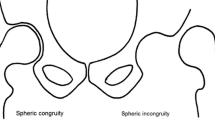Abstract
Palliative Schanz proximal femoral valgus osteotomy is considered a common option for treatment of irreducible hip dislocation in cerebral palsy. From 1992 to 2005, Schanz osteotomy was indicated on 55 occasions in 35 nonambulatory patients with the quadriplegic form of cerebral palsy aged 9–18. Postoperatively, the main emphasis focussed on clinical presentation, improvement of hip range of motion, and pain relief. X-rays were carried out at three, six, and 12 months postoperatively with subsequent average follow up 98 ± 4.5 months. In all patients, the range of hip abduction and flexion increased. In 54 (98.2%) cases painful symptoms significantly improved. One patient (1.8%) had a subsequent femoral head excision because of persistent hip pain. Transient hip pain persisted in four patients (7.3%). Schanz valgus osteotomy improves the hip range of motion, relieves pain, and facilitates care of the patient. Schanz femoral osteotomy is a less invasive method compared to proximal femoral excision and should preferably be used in older children with neurogenic hip dislocation in whom reconstructive surgery is not indicated.
Résumé
L’ostéotomie de Schanz est considérée comme un traitement possible des luxations irréductible chez l’infirme moteur cérébral. De 1992 à 2005, une ostéotomie de Schanz a été réalisée 55 fois chez 35 patients non marchant et présentant une quadriplégie spastique, ces patients étaient âgés de 9 à 18 ans. La surveillance postopératoire a été centrée sur l’examen clinique, l’amélioration de la mobilité et l’amélioration des phénomènes douloureux. Les radios ont été réalisées à 3, 6 et 12 mois postopératoires avec un suivi moyen de 98 mois ± 4,5 mois. Chez tous les patients la mobilité de la hanche en abduction et en flexion s’est améliorée. Dans 54 cas (98,2%) la diminution de la douleur est significative. Un patient (1,8%) a nécessité d’une résection de la tête fémorale du fait de douleurs persistantes. Une douleur transitoire a persisté chez 4 patients (7,3%). L’ostéotomie de Schanz améliore la mobilité et la douleur de ces patients. Cette intervention est peu invasive comparée à la résection de l’extrémité supérieure du fémur et peut être préférée chez les enfants âgés présentant une luxation neurologique pour lesquels il n’est pas possible de réaliser une reconstruction de la hanche.



Similar content being viewed by others
References
Atar D, Grant AD, Bash J, Lehman WB (1995) Combined hip surgery in cerebral palsy patients. Am J Orthop 24:52–55
Barrie JL, Galasko CS (1996) Surgery for unstable hips in cerebral palsy. J Pediatr Orthop 5-B:225–231
Bully RL, Huo M, Root L et al (1993) Total hip arthroplasty in cerebral palsy. Long- term follow-up results. Clin Orthop 296:148–153
Castle ME, Schneider C (1978) Proximal femoral resection-interposition arthroplasty. J Bone Jt Surg 60-A:1051–1054
Cornell MS (1995) The hip in cerebral palsy. Dev Med Child Neurol 37:3–18
Dapic T, Cuti T, Anticevic D, Sakic S (2004) Hip dislocation in children with cerebral palsy. Paediatr Croat 48(4):191–196
De Moraes Barros Fucs PM, Svartman C, De Assumpcao RM, Kertzman PF (2003) Treatment of the painful chronically dislocated and subluxated hip in cerebral palsy with hip arthrodesis. J Pediatr Orthop 23:529–534
Dobson F, Boyd RN, Parrott J, Nattrass GR, Graham HK (2002) Hip surveillance in children with cerebral palsy. Impact on the surgical management of spastic hip disease. J Bone Jt Surg Br 84:720–726
Faflik J, Bik K, Lipczyk Z (2002) An evaluation of surgical outcomes in luxation and subluxation of the hip joint in children with cerebral palsy. Orthop Traumatol Rehab 4(1):15–20
Flynn JM, Miller F (2002) Management of hip disorders in patients with cerebral palsy. J Am Acad Orthop Surg 10:198–209
Girdlestone GR (1943) Acute pyogenic arthritis of the hip. An operation giving free access and effective drainage. Lancet 1:419–421
Hagglund G, Andersson S, Duppe H, Lauge Pedersen H, Nordmark E, Westbom L (2005) Prevention of dislocation of the hip in children with cerebral palsy. The first ten years of a population-based prevention programme. J Bone Joint Surg Br 87(1):95–101
Herring JA (2002) Tachdjian’s pediatric orthopedics, 3rd edn. W.B. Saunders, Philadelphia, p 2438
Knapp DR Jr, Cortes H (2002) Untreated hip dislocation in cerebral palsy. J Pediatr Orthop 22:668–671
Leet AI, Chor K, Launay F, Kier York J, Sponseller PD (2005) Femoral head resection for painful hip subluxation in cerebral palsy: is valgus osteotomy in conjunction with femoral head resection preferable to proximal femoral head resection and traction? J Pediatr Orthop 25(1):70–73
McHale KA, Bagg M, Nason SS (1990) Treatment of the chronically dislocated hip in adolescents with cerebral palsy with femoral head resection and subtrochanteric valgus osteotomy. J Pediatr Orthop 10(4):504–509
Milch H (1955) The resection-angulation operation for hip joint disabilities. J Bone Jt Surg Am 37:699–717
Presedo A, Oh CW, Dabney KW, Miller F (2005) Soft-tissue releases to treat spastic hip subluxation in children with cerebral palsy. J Bone Joint Surg Am 87(4):832–841
Root L, Goss JR, Mendes J (1986) The treatment of the painful hip in cerebral palsy by total hip replacement or hip arthrodesis. J Bone Joint Surg 68A:590–597
Schanz A (1921) Zur Behandlung der veralteten angeborenen Hüftverrenkung. Z Orthop 42:442–444
Schejbalová A, Smetana V (2000) Iliopsoas muscle—one of the causes of neurogenous dislocation: technique of tenotomy and lengthening. Acta Chir orthop Traum Cech 67:234–238
Song HR, Carroll NC (1998) Femoral varus derotation osteotomy with or without acetabuloplasty for unstable hips in cerebral palsy. J Pediatr Orthop 18:62–68
Stasikelis PJ, Allen BL Jr (2004) Osteonecrosis after proximal femoral osteotomy in spastic encephalopathy. Orthopedics 27(3):330–332
Tachdjian MO (1990) Pediatric orthopedics, 2nd edn. Saunders, Philadelphia, p 3372
Wicart P, Barthas J, Guillaumat M (1999) Replacement arthroplasty of paralytic hip. Apropos of 18 cases. Rev Chir Orthop Repatrice Appart Mot 85(6):581–590
Acknowledgement
The work was supported by grant IGA MZ NR 8333-3.
Author information
Authors and Affiliations
Corresponding author
Rights and permissions
About this article
Cite this article
Schejbalova, A., Havlas, V. & Trc, T. Irreducible dislocation of the hip in cerebral palsy patients treated by Schanz proximal femoral valgus osteotomy. International Orthopaedics (SICOT) 33, 1713–1717 (2009). https://doi.org/10.1007/s00264-008-0676-y
Received:
Revised:
Accepted:
Published:
Issue Date:
DOI: https://doi.org/10.1007/s00264-008-0676-y




